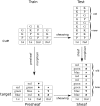Going Beyond the Data as the Patching (Sheaving) of Local Knowledge
- PMID: 30356817
- PMCID: PMC6189483
- DOI: 10.3389/fpsyg.2018.01926
Going Beyond the Data as the Patching (Sheaving) of Local Knowledge
Abstract
Consistently predicting outcomes in novel situations is colloquially called "going beyond the data," or "generalization." Going beyond the data features in spatial and non-spatial cognition, raising the question of whether such features have a common basis-a kind of systematicity of generalization. Here, we conceptualize this ability as the patching of local knowledge to obtain non-local (global) information. Tracking the passage from local to global properties is the purview of sheaf theory, a branch of mathematics at the nexus of algebra and geometry/topology. Two cognitive domains are examined: (1) learning cue-target patterns that conform to an underlying algebraic rule, and (2) visual attention requiring the integration of space-based feature maps. In both cases, going beyond the data is obtained from a (universal) sheaf theory construction called "sheaving," i.e., the "patching" of local data attached to a topological space to obtain a representation considered as a globally coherent cognitive map. These results are discussed in the context of a previous (category theory) explanation for systematicity, vis-a-vis, categorical universal constructions, along with other cognitive domains where going beyond the data is apparent. Analogous to higher-order function (i.e., a function that takes/returns a function), going beyond the data as a higher-order systematicity property is explained by sheaving, a higher-order (categorical) universal construction.
Keywords: category theory; generalization; learning; sheaf; sheaf theory; sheaving; universal.
Figures
Similar articles
-
Sheaving-a universal construction for semantic compositionality.Philos Trans R Soc Lond B Biol Sci. 2020 Feb 3;375(1791):20190303. doi: 10.1098/rstb.2019.0303. Epub 2019 Dec 16. Philos Trans R Soc Lond B Biol Sci. 2020. PMID: 31840582 Free PMC article.
-
Systematicity and a Categorical Theory of Cognitive Architecture: Universal Construction in Context.Front Psychol. 2016 Jul 29;7:1139. doi: 10.3389/fpsyg.2016.01139. eCollection 2016. Front Psychol. 2016. PMID: 27524975 Free PMC article.
-
Second-Order Systematicity of Associative Learning: A Paradox for Classical Compositionality and a Coalgebraic Resolution.PLoS One. 2016 Aug 9;11(8):e0160619. doi: 10.1371/journal.pone.0160619. eCollection 2016. PLoS One. 2016. PMID: 27505411 Free PMC article.
-
Category representation and generalization in the prefrontal cortex.Eur J Neurosci. 2012 Apr;35(7):1083-91. doi: 10.1111/j.1460-9568.2011.07981.x. Eur J Neurosci. 2012. PMID: 22487038 Review.
-
Cognitive maps and attention.Prog Brain Res. 2009;176:181-94. doi: 10.1016/S0079-6123(09)17610-0. Prog Brain Res. 2009. PMID: 19733757 Review.
Cited by
-
A category theory perspective on the Language of Thought: LoT is universal.Front Psychol. 2024 Apr 30;15:1361580. doi: 10.3389/fpsyg.2024.1361580. eCollection 2024. Front Psychol. 2024. PMID: 38746919 Free PMC article. Review.
-
On the Design of Social Robots Using Sheaf Theory and Smart Contracts.Front Robot AI. 2021 Aug 18;8:559380. doi: 10.3389/frobt.2021.559380. eCollection 2021. Front Robot AI. 2021. PMID: 34490353 Free PMC article.
-
Sheaving-a universal construction for semantic compositionality.Philos Trans R Soc Lond B Biol Sci. 2020 Feb 3;375(1791):20190303. doi: 10.1098/rstb.2019.0303. Epub 2019 Dec 16. Philos Trans R Soc Lond B Biol Sci. 2020. PMID: 31840582 Free PMC article.
-
What is category theory to cognitive science? Compositional representation and comparison.Front Psychol. 2022 Nov 18;13:1048975. doi: 10.3389/fpsyg.2022.1048975. eCollection 2022. Front Psychol. 2022. PMID: 36467129 Free PMC article. Review.
References
-
- Abramsky S., Brandenburger A. (2011). The sheaf-theoretic structure of non-locality and contextuality. New J. Phys. 13:113036 10.1088/1367-2630/13/11/113036 - DOI
-
- Aizawa K. (2003). The Systematicity Arguments. Studies in Mind and Brain. New York, NY: Kluwer Academic.
-
- Andrews G., Halford G. S. (1998). Children's ability to make transitive inferences: the importance of premise integration and structural complexity. Cogn. Dev. 13, 479–513. 10.1016/S0885-2014(98)90004-1 - DOI
Publication types
LinkOut - more resources
Full Text Sources




